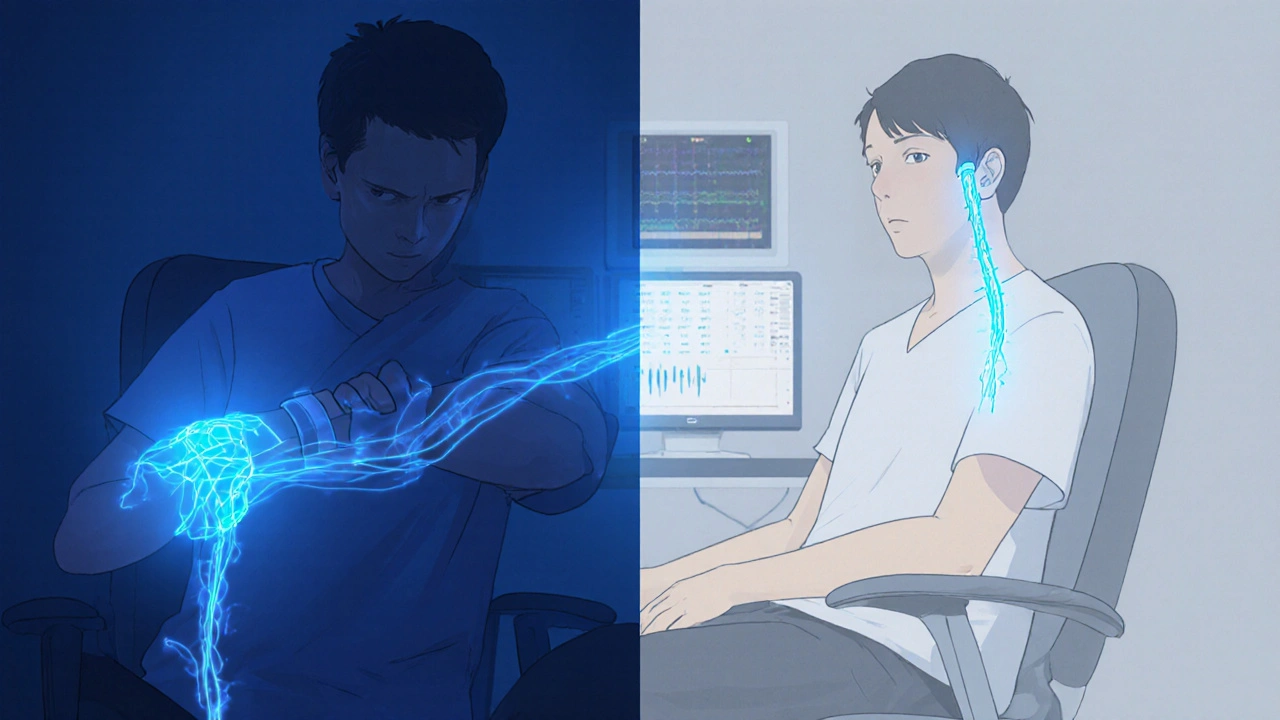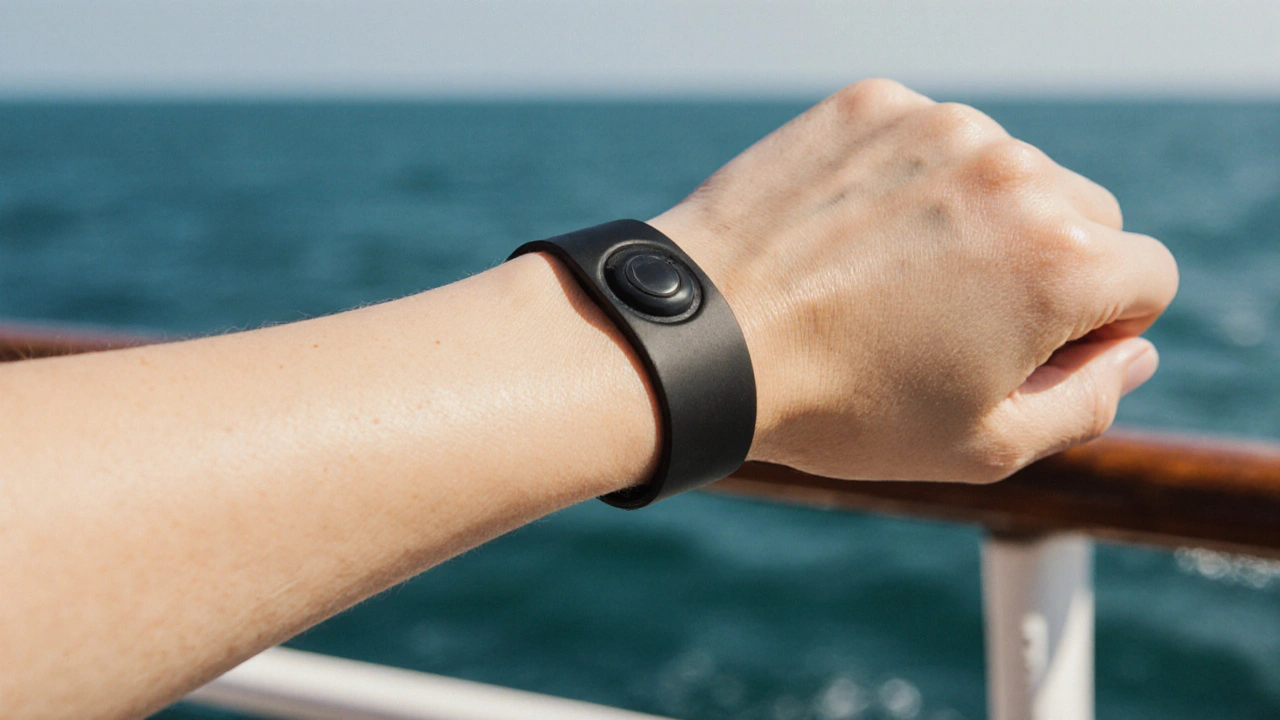Motion Sickness Relief Calculator
Your Personalized Recommendation
Correct P6 Point Placement
Place three finger-widths below the wrist crease, between the two visible tendons. You should feel a slight indentation—the Nei-Kuan (P6) point.
Motion sickness bands are acupressure wristbands that claim to ease nausea by pressing on the Nei‑Kuan point on the inner wrist. If you’ve ever felt queasy on a boat, in a car, or while gaming, you’ve probably wondered whether these rubber bands are a clever trick or a legit solution. Below we break down the science, compare them to meds and natural options, and give you a clear answer so you can decide what to pack for your next trip.
How the bands are supposed to work
The idea behind motion sickness bands comes from acupressure, a practice that applies pressure to specific points on the body to influence organ function. The targeted point, called Nei‑Kuan (P6), sits three finger‑widths below the wrist crease between the two tendons. Proponents say stimulating P6 can calm the vagus nerve, which relays signals between the gut and brain. When the vagus nerve fires off mixed messages during motion, the brain can interpret them as nausea. By pressing P6, the bands aim to modulate that signal and reduce the feeling of queasiness.
What the research actually says
Several clinical trials have tested P6 stimulation against placebos. A 2015 meta‑analysis of 12 double‑blind studies found that acupressure wristbands reduced self‑reported nausea by an average of 23% compared to sham bands. However, the same review noted high variability: some studies showed no difference at all. The placebo effect appears to play a big role-participants who believed the bands would help often reported less nausea, even when the band’s pressure was off‑center.
How they stack up against common remedies
| Solution | How it works | Typical effectiveness* | Side effects | Cost (US$) |
|---|---|---|---|---|
| Motion sickness bands | Acupressure on P6 point | ~20‑30% reduction | None for most users | 15‑30 (pair) |
| Dimenhydrinate (Dramamine) | Antihistamine that blocks signals to the brain | ~50‑60% reduction | Drowsiness, dry mouth | 0.50‑1 per tablet |
| Scopolamine patch | Anticholinergic absorbed through skin | ~70‑80% reduction | Blurred vision, confusion | 20‑30 (24‑hr patch) |
| Ginger (candied, capsules) | Natural anti‑emetic compounds | ~15‑25% reduction | Heartburn in high doses | 2‑5 per ounce |
*Effectiveness numbers are averages from multiple studies and can vary by individual.

When the bands work best
People who report the biggest benefit tend to share a few traits:
- They experience mild‑to‑moderate nausea (often travel nausea that starts within the first 30 minutes of motion).
- They have a strong belief in non‑pharmacologic fixes.
- They use the band correctly-pressure applied directly over the P6 point and worn on both wrists.
If you have severe motion sickness, a history of migraines, or need reliable relief for long cruises, the bands alone might not cut it.
Potential downsides and safety notes
While the bands are generally safe, a few caveats are worth noting:
- Improper placement can cause skin irritation or a feeling of numbness.
- People with wrist injuries or carpal tunnel syndrome should avoid tight pressure.
- They don’t address the root cause of motion‑induced imbalance; they merely mask symptoms.
Unlike antihistamines, there’s no drowsiness, which makes bands attractive for drivers or pilots who can’t afford sedation.
How to choose the right solution for you
Think of the decision as a mini‑checklist:
- Severity: Mild nausea → try bands; moderate‑to‑severe → consider medication.
- Timing: Need immediate relief? Meds work within 30‑60 minutes; bands work instantly if placed correctly.
- Side‑effect tolerance: Avoid drowsiness or anticholinergic risks? Bands are a safe bet.
- Budget: One pair lasts many trips and costs less than a pack of tablets.
- Personal philosophy: Prefer natural, non‑drug approaches? Bands fit the bill.
Many travelers use a hybrid approach-bands for the first few hours of a trip, then a backup antihistamine if nausea spikes.

Real‑world experiences
Jane, a 34‑year‑old avid sailor, says she bought a pair of wristbands after a rough Atlantic crossing left her feeling sick for days. "I put them on before we left port and felt fine the whole time. When we hit a sudden squall, the nausea that usually hits me was barely noticeable," she reports.
Conversely, Mark, a 45‑year‑old truck driver, tried the same bands on a long highway route and felt nothing. "I was hoping for a quick fix, but I still needed my prescription medication. I think the bands work for lighter cases, not for the intense motion you get in a big rig," he notes.
Bottom line: Do they work?
Answering the headline question: motion sickness bands do provide measurable relief for a subset of users, especially those with mild symptoms and a belief in acupressure. They’re safe, inexpensive, and drug‑free, but they’re not a universal cure. If you’re prone to strong nausea, pairing the bands with a proven medication or a natural anti‑emetic like ginger gives the best odds of a comfortable journey.
Frequently Asked Questions
How long should I wear the bands before feeling relief?
Most users report a noticeable decrease in nausea within 5‑10 minutes of proper placement. For best results, keep the bands on for the entire duration of the motion event.
Can I use the bands while taking medication?
Yes. Since the bands have no pharmacological action, they can safely complement antihistamines, scopolamine patches, or ginger supplements. Just make sure the medication’s dosage guidelines are followed.
Are there any people who should avoid these bands?
Anyone with a wrist injury, severe skin sensitivity, or a known allergy to the band’s material should skip them. If you have carpal tunnel syndrome, the pressure might worsen symptoms.
Do the bands work for motion sickness caused by VR gaming?
VR‑induced nausea shares the same vestibular mismatch as travel sickness, so many users find the bands helpful. However, results vary, and you may still need to take breaks or adjust your headset settings.
How do I know I’m pressing the correct point?
Place three finger‑widths below the wrist crease, between the two visible tendons. You should feel a slight indentation-this is the Nei‑Kuan (P6) point. Many bands include a marked area to guide placement.


Anna Marie
October 10, 2025 AT 23:08I appreciate the thorough breakdown and will definitely try the bands on my next road trip.
Abdulraheem yahya
October 17, 2025 AT 21:48I’ve been chasing a smooth ride for years, especially on the winding highways between Lagos and Abuja.
I placed the band exactly three finger‑widths below my wrist crease, making sure the pressure hit the tender spot between the tendons.
Within five minutes I felt a subtle calm in my stomach, as if the nausea wave was being dampened.
That initial success encouraged me to test the bands on longer trips, like the six‑hour drive to Calabar.
During that journey the road was rough, the bus bounced, and my fellow passengers complained about motion sickness.
I kept the bands on both wrists, and while a few passengers reached for their ginger tablets, I stayed relatively steady.
The bands didn’t eliminate the queasy feeling entirely, but they reduced it enough that I could read a book without constantly stopping.
I also tried them while playing VR games at home, and the virtual roller‑coaster didn’t make me sprint to the bathroom as it normally would.
When I compared notes with friends who used Dramamine, the medication cleared the nausea faster but left them drowsy.
The bands, on the other hand, kept me alert, which is crucial for drivers or anyone who needs to stay focused.
A meta‑analysis I skimmed showed roughly a 20‑30 % improvement over placebo, matching my personal experience.
The placebo effect can’t be dismissed, though, because belief in a non‑pharmacologic solution seems to boost the outcome.
If you have severe motion sickness, the bands alone might not be enough, but they are a low‑risk supplement to other strategies.
In summary, the bands work best for mild to moderate symptoms, when used correctly, and they’re cheap enough to keep a spare in your bag.
Give them a try on a short trip first, and decide if the relief justifies making them a permanent travel companion.
Preeti Sharma
October 24, 2025 AT 20:28While the data shows a modest benefit, I’m inclined to argue that the placebo component overshadows any physiological effect. The human mind is a powerful engine that can turn rubber bands into miracles or mirages. Moreover, most studies suffer from small sample sizes and inconsistent placement protocols. If you’re looking for a scientifically robust remedy, a medication with known pharmacodynamics is preferable. Still, the low risk of bands makes them a curious experiment for the open‑minded.
Ted G
October 31, 2025 AT 19:08They say the bands are harmless, but have you considered how widespread pressure‑point devices are being used to monitor biometric data? Some manufacturers embed sensors that could feed data to third parties without consent. Stay skeptical and read the fine print before you trust any wearable.
Miriam Bresticker
November 7, 2025 AT 17:48I’ve read the meta‑analysis, and it’s fascinating 🤔. The 23 % reduction isn’t groundbreaking, but for a $20 pair it’s decent 😊. If you combine bands with ginger tea, you might edge closer to a 35 % improvement. Just remember to place them correctly, or you’ll just be squeezing your wrist for nothing 😂. Overall, it’s a harmless experiment worth a try!
Claire Willett
November 14, 2025 AT 16:28Acupressure UI aligns with vestibular feedback loop. Proper P6 actuation yields measurable nausea attenuation. Cost‑benefit ratio favors wristband for low‑risk deployments.
olivia guerrero
November 21, 2025 AT 15:08Wow, what an informative post, thank you for breaking down the science, the tables, and the personal anecdotes, all in one place! I love that you mentioned both the placebo effect and the actual physiological mechanisms, because balance is key! This will definitely help me decide what to pack for my upcoming cruise, and I’m already feeling more confident! Keep the great content coming, and feel free to add a quick FAQ on band maintenance!
Claire Kondash
November 28, 2025 AT 13:48Reading through the article felt like taking a mini‑lecture on vestibular physiology, and I must say the depth impressed me 😃. The historical context of P6 stimulation, dating back to ancient Chinese medicine, adds a layer of cultural richness that many modern studies overlook 📜. While the numbers suggest only a modest benefit, the psychological comfort of having a tangible tool in your pocket cannot be dismissed 🌟. I’ve personally used the bands on a three‑hour ferry ride, and although the nausea didn’t vanish entirely, it stayed at a low, manageable level 🚢. Pairing the bands with controlled breathing techniques created a synergistic effect that surpassed either method alone 🤓. For those skeptical about the placebo, consider that expectation itself can modulate the vagus nerve, blurring the line between mind and body 🧠. In short, treat the bands as a low‑cost adjunct rather than a miracle cure, and you’ll likely appreciate the nuanced benefits.
Matthew Ulvik
December 5, 2025 AT 12:28Hey folks, just wanted to say the bands are a solid tool for mild motion sickness. Put them on both wrists and make sure the pressure hits the P6 spot. If it doesn’t work for you, mix in ginger or a light antihistamine and you’ll be good.